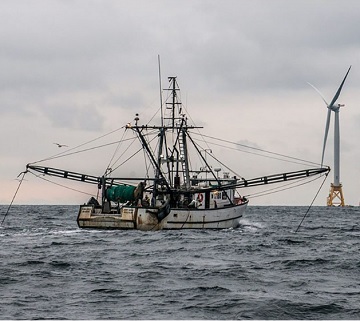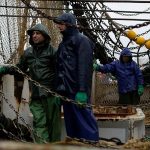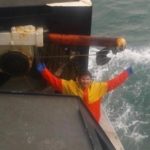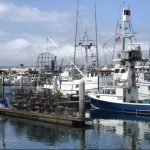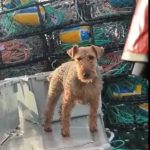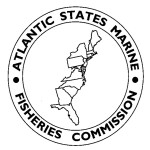Tag Archives: offshore wind farms
NJ Fishing Pros Warn Offshore Wind Killing Ocean Life: ‘Never Seen Anything Remotely Like This’ in Half a Century
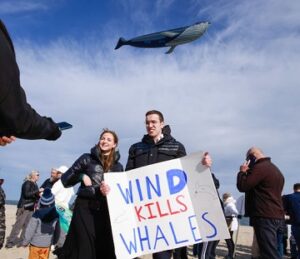 New Jersey is in the process of approving two major offshore wind projects: the Ocean Wind I and II initiatives owned by the Danish “green” energy company Ørsted. Radical leftist Governor Phil Murphy ordered a massive restructuring of the state’s power grid in September to become reliant on “100 percent clean energy by 2035” that has enjoyed enthusiastic support from the White House, which approved Ocean Wind I in July. To install the wind turbines necessary for the projects, engineers must survey and map the ground floor to find the ground best able to sustain the massive structures. The survey work being done in anticipation of the installation of these turbines has coincided with a massive increase in the number of dead whales and other marine mammals off the coasts of New York and New Jersey. >click to read< 10:28
New Jersey is in the process of approving two major offshore wind projects: the Ocean Wind I and II initiatives owned by the Danish “green” energy company Ørsted. Radical leftist Governor Phil Murphy ordered a massive restructuring of the state’s power grid in September to become reliant on “100 percent clean energy by 2035” that has enjoyed enthusiastic support from the White House, which approved Ocean Wind I in July. To install the wind turbines necessary for the projects, engineers must survey and map the ground floor to find the ground best able to sustain the massive structures. The survey work being done in anticipation of the installation of these turbines has coincided with a massive increase in the number of dead whales and other marine mammals off the coasts of New York and New Jersey. >click to read< 10:28
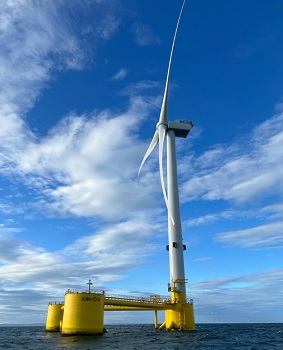
Leeman: Maine must hit pause on offshore wind turbines
You wouldn’t buy a house without an inspection, so why would we fill the Gulf of Maine with wind turbine superstructures without understanding how they interact with the marine environment? Offshore wind energy features too many unknowns to proceed at this point with widescale ocean industrialization. That’s why my organization, the New England Fishermen’s Stewardship Association (NEFSA) has joined with partner organizations to call on state and federal authorities to reset our renewable energy policy. The state of Maine is developing a floating offshore wind research array at a 15-square-mile site in the Gulf of Maine. >click to read< 08:17

Offshore wind foes sue New Jersey and Danish turbine developer over tax break
The lawsuit was filed Thursday by two residents’ groups that are opposed to offshore wind projects and three electricity customers from Ocean City who seek to overturn the law. They say it gives Orsted about $1 billion in tax relief for one of the two windmill projects it plans to build off the state’s southern coast. The state Legislature passed a bill allowing Orsted to keep federal tax credits that it was obligated to pass along to ratepayers. In applying for permission to build the project, called Ocean Wind I, Orsted had promised to return such credits to customers. Bruce Afran, a lawyer representing two groups who brought the lawsuit – Protect Our Coast NJ and Defend Brigantine Beach – said the state is not permitted to enact laws that benefit only one party. >click to read< 09:55
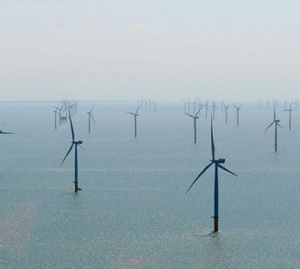
Offshore Wind has a Cost Crisis
The horrific term “cost crisis” is not from me. It comes down from on high, in this case the mega-conference: US Offshore Wind 2023. But now they have a cost crisis. Could the bust be at hand? The evidence is piling up. So there are three converging factors. Higher material and equipment costs, higher interest rates and political resistance. For example it has not gone unnoticed that the House Republicans are trying to roll back the lush subsidies granted under the amusingly named Inflation Reduction Act. Local resistance is growing as well. The biggest developer offshore America is Ørsted and they are now suing New Jersey’s Cape May County and Atlantic City for withholding local permits needed to bring a big project’s power ashore. Anti-offshore wind demonstrations are becoming a common occurrence in coastal towns. >click to read< 08:02
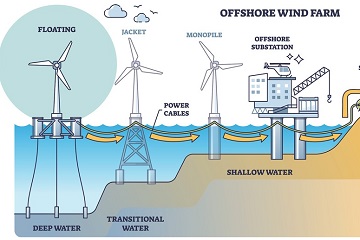
Humboldt Bay – Port of Entry
Big changes are afoot on the Samoa Peninsula. The Humboldt Bay Harbor, Recreation and Conservation District is planning to construct a large manufacturing center to craft and assemble giant wind turbines suitable for the deep offshore waters of the Pacific Coast. Officially known as the Humboldt Bay Offshore Wind Heavy Lift Multipurpose Marine Terminal Project, the port development is a crucial step to bring plans to build a first-of-its kind wind farm off the Pacific Coast to fruition. It would also position Humboldt’s as the only port on the West Coast built to manufacture and repair the turbines — a potential economic boon for the area as the industry enters a period of unprecedented growth. In an effort to address the climate crisis, the Biden administration issued an executive order about a year ago requiring 30 gigawatts of energy to be produced by offshore winds by 2030. >click to read< 10:04
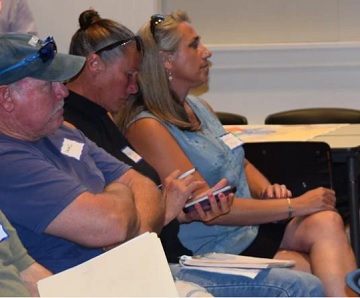
Maine Fishermen, scientists find flaws in potential wind energy lease areas
BOEM officials called the meeting to review newly released draft maps of where federal leases could be offered in the Gulf of Maine, known as the “call” area. They wanted fishermen’s feedback to see where the maps fell short based on what fishermen know from working on the water. “This is very difficult for our industry to face,” said Dustin Delano, New England Fishermen Stewardship’s chief operating officer, former vice president of the Maine Lobster Association and a fourth-generation lobsterman out of Friendship. “A lot of us feel this is going to wipe us off the map.” The fishermen present were unconvinced but resigned. >click to read< 07:55
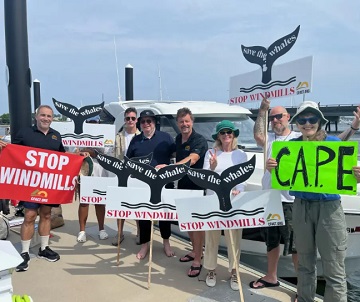
Fishermen, activists protest offshore wind farms near Montauk, cite recent whale deaths
The winds of change are blowing. Conservative activists, environmentalists and New Jersey fishermen protested the construction of wind turbines off the East Coast on Monday, highlighting increasing whale deaths in the region that they say are tied to offshore renewable energy. The coalition, organized by the Committee for a Constructive Tomorrow, sent out three boats to South Fork Wind Farm, roughly 20 miles from both Martha’s Vineyard and Montauk, NY, holding signs that read “STOP WINDMILLS SAVE WHALES” while shouting through a bullhorn at machinery operators to halt construction. The National Oceanic and Atmospheric Administration (NOAA) in 2017 declared an “unusual mortality event” for humpback whales found dead on beaches from Maine to Florida. The agency has recorded 57 large whale strandings since December 1, 2022 on the Atlantic coast. Twelve occurred in New York; nine were discovered in New Jersey. Photos, >click to read< 09:04
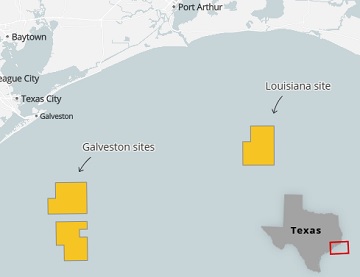
First offshore wind leases off the Texas coast offered for bidding
The federal government on Thursday announced the first-ever chance for companies to lease areas in the Gulf of Mexico to build wind farms, including two parcels roughly 30 miles off the Texas coast near Galveston. Renewable energy developers will likely compete for the leases with firms that are better known for another kind of offshore construction: Oil and gas giants such as Shell and TotalEnergies qualified to join the bidding. Leaders of the traditionally fossil fuel-focused companies say their climate goals make investing in offshore wind critical. Both businesses are already involved in developing wind power in the Atlantic, including near New Jersey, New York and Massachusetts. >click to read< 10:02

American boat patrols waters around new offshore wind farms to protect jobs
A battleship-gray vessel was on the prowl. In this ramp-up for U.S. offshore wind, American marine companies and mariners fear they’ll be left behind. So Aaron Smith, president of the Offshore Marine Service Association, was looking through binoculars to see whether ships servicing the new wind farms were using foreign-flagged vessels instead of U.S.-made ships with American crews. The ship is named the Jones Act Enforcer, after the century-old law that says the transport of merchandise between U.S. points is reserved for U.S.-built, owned and documented vessels. The motto: “We’ll be watching.” Smith was documenting operations to show to federal law enforcement officials and members of Congress. 15 Photos, >click to read< 10:02
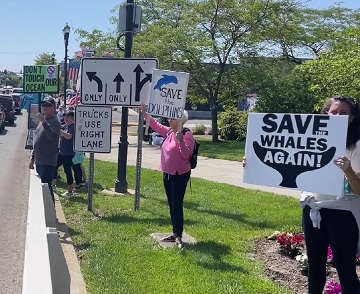
Weekend event to challenge wind farm plans up and down shore
Offshore wind power opponents scheduled a waterfront protest starting at 11 a.m. Saturday, with plans for participants to gather on beaches throughout South Jersey. Some have posted plans to gather in Ocean City, Wildwood Crest, on Long Beach Island and on Atlantic County beaches. “This is not just an Ocean City event. This is all New Jersey beaches and beyond,” said Adrienne Possenti, a Vineland resident who is helping organize the Ocean City gathering. But she said the Ocean City gathering is particularly urgent as the plans call for cables to pass under the city to bring offshore wind power to the grid. “If we can stop that, we stop the rest of the project,” Possenti said Wednesday. >click to read< 09:38
Wind Farm Protesters to “Link Hands” on Beaches – Opponents of a proposed wind energy farm off the South Jersey coast will link hands on the beaches Saturday in a protest symbolizing their unified fight against a project they believe will be an environmental and economic disaster. Photos, info, >click to read< 11:30
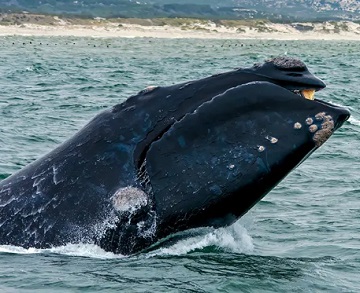
The Whale Killing Study the Feds are Afraid to Do
The Feds have admitted that offshore wind development can cause the death of whales and other marine mammals, but they refuse actually to assess that threat for any wind facilities. So I here outline what such a study should look like. This sort of study is what they are afraid to do because it would give numbers to the deaths that are likely to occur, species by species. First off, here is the Feds’ own description of some of the known deadly threats. In this case, the offshore wind activity is driving the monster piles that support the turbine towers, but there are others. >click to read< 10:02
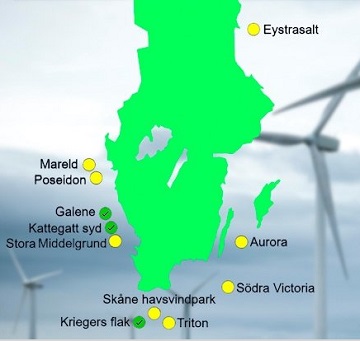
Swedish Fishermen Vow to Fight-On Against Offshore Wind Developments
The Swedish Fisherman’s Producers Organisation (SFPO) has submitted an application for judicial review to the Supreme Administrative Court regarding the government’s decision on the Kattegat Syd (South) and Galene wind farms. The action by the organisation follows on from the protests held in Lomma, Varberg and Gothenberg on 16 June last against the Swedish government’s decision to allow the construction of offshore wind turbines in the Kattegat, on valuable fishing grounds for the local Swedish fleet. The protest under the banner “No Wind Power on Our Fishing Grounds” was organised by the SFPO, the largest fishing organisation in Sweden. Since the protests, it was announced by the Uddevalla Municipality Board that there would be two large offshore wind farms (Mareid and Poseidon) constructed off Bohuslän in the municipality which would have serious consequences for fishermen there. >click to read< 14:04

Misinformation: Offshore wind isn’t killing whales. Big oil and gas just want you to think it is.
While ocean conservation organizations and scientists are raising the alarm about how climate change is harming whales, lobbyist groups, online news outlets, and conservative representatives have found a convenient scapegoat for these whale deaths: offshore wind farms. Self-styled “grassroots” groups like Protect Our Coast New Jersey, Save Our Beach View, Nantucket Residents Against Turbines, and the American Coalition for Ocean Protection claim that the technology used in the surveying phase of offshore wind farm development is killing whales — without any supporting evidence. Indeed, representatives from NOAA Fisheries, a bioacoustics expert at the University of Southern Denmark, and scientists at the Bureau of Ocean Energy Management are all on the record stating that there are no known ties between offshore wind and whale deaths. >click to read< 15:29
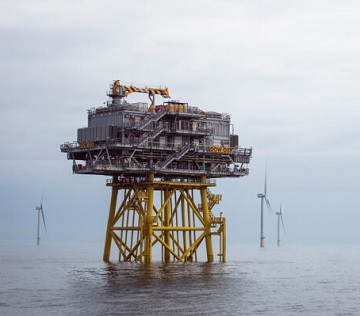
Letter: Informative wind energy resources out there, by Carol Frazier
I just watched a video on YouTube entitled “Bonnie Brady’s Crash Course in Offshore Wind and the Anti-Fishing Lobby”. I don’t recall any of our local news media (other than Mike Bradley of WGMD 92.7 fm) reporting on any of the information and facts contained therein. That said, I have also been made aware of a new fact regarding offshore wind of which people need to be aware. The wind turbines must be regularly “cooled” which is done by drawing ocean water into electrical substations using “once through” cooling systems – these systems are now prohibited in newer power plants because of the devastating effects on aquatic life. The first planned project off our coast calls for 121 turbines and up to four transfer stations. I would suggest everyone read the article “Offshore Wind Electrical Substations: The Secret, Silent Killers” by Jim Lovgren at Fisherynation.com. >click to read the letter< 08:38
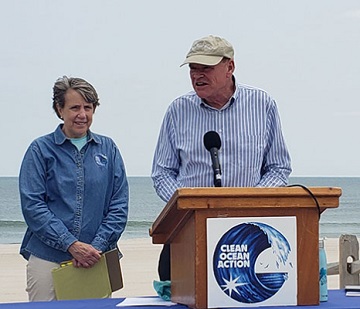
World Ocean Day Prompts Calls for Action
Calling themselves “Ocean Rebels for the COZ” members of Clean Ocean Action (COA), Mayor John Peterson, naturalist Trisha DeVoe and others came out to promote for the aquatic environment during World Ocean Day. Those present noted that after four decades of progress in ocean protection, new and old threats were being fast tracked that could impact the ocean of today. Peterson said he hoped to see “officials of all elected levels of government, up and down the Jersey shore” in joining COA  in making the public aware “of the threats to our ocean and what can happen if we become complacent. Lavallette resident Brick Wenzel spoke to Jersey Shore Online.com from the perspective of a commercial fisherman. “I am the fishing liaison for the Fishermen’s Dock Cooperative out of Point Pleasant Beach. I have been a licensed commercial fisherman since 1982. When you look at the industrialization of our ocean, the commercial fishing industry is the most heavily impacted blue water economy with the industrial build out.” Photos, >click to read< 12:51
in making the public aware “of the threats to our ocean and what can happen if we become complacent. Lavallette resident Brick Wenzel spoke to Jersey Shore Online.com from the perspective of a commercial fisherman. “I am the fishing liaison for the Fishermen’s Dock Cooperative out of Point Pleasant Beach. I have been a licensed commercial fisherman since 1982. When you look at the industrialization of our ocean, the commercial fishing industry is the most heavily impacted blue water economy with the industrial build out.” Photos, >click to read< 12:51
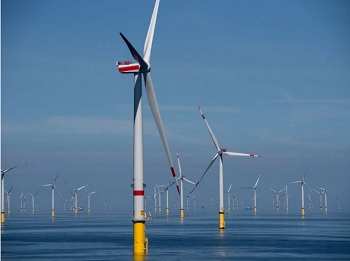
The dirty details of offshore wind’s ‘clean energy’
“In New Jersey, it’s go hard or go home,” Gov. Phil Murphy Tweeted after signing an executive order to up the state’s offshore wind goals by nearly 50% last September. Perhaps, the governor didn’t consider the fact that those in the state who question the perils and efficacy of offshore wind turbines are playing by the same saying. This “clean energy economy,” as conceived and fast-tracked by the Biden administration (and treated as the holy grail by Gov. Phil Murphy), has been shoved down the throats of those who live in shore communities, even though the risks to every aspect of marine life are poorly understood and little evidence exists that wind energy will make a noteworthy impact on climate change. By Linda Bonvie, >click to read< 09:53

Corporate Welfare: Lawmakers pass controversial bill to give tax break to offshore wind developer
Lawmakers narrowly advanced fast-tracked legislation Friday that would give a Danish company a multimillion-dollar tax break for its offshore wind project, despite objections from Republicans who slammed it as “corporate welfare.” The bill would allow Ørsted, the company approved to build a 1,100-megawatt project 15 miles off the Atlantic City coastline, to keep federal tax credits that otherwise would return to ratepayers. The value of the credit would be $2.40 per year per ratepayer, by Ørsted’s estimate, but the company’s total potential savings is unclear. Critics questioned why legislators should give “a corporate bailout to a foreign company on the backs of New Jersey ratepayers,” as Assemblywoman Vicky Flynn (R-Monmouth) put it. >click to read< 09:25
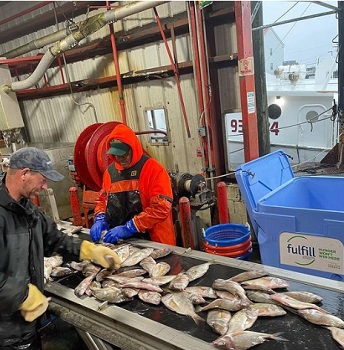
Commercial fisherman in NJ speaks out about wind turbine plan
Brick Wenzel is a commercial fisherman at the Jersey Shore. He joined me on my “Common Ground with Bill Spadea” podcast and on the broadcast this week. Brick is speaking out against the governor’s wind turbine plan, joining a chorus of opposition hoping to end the project once and for all. As I mentioned, when he appeared on the podcast he came bearing gifts! The fresh squid right off of one of his boats was a welcome treasure! As you know, Jodi got it on ice and we cooked it up the next night. Brick explained that one of the missions he’s on, in addition to commercial fishing and battling the wind project, is to provide protein to the folks who are truly food insecure. His organization is able to gather fish that has very little to no market value and deliver them to food banks across the state. Watch the podcast, key to 30:07 >click to read< 09:31
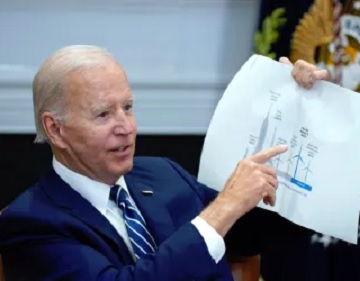
Biden admin under fire for offshore wind impacts on military operations
Earlier this week, Rep. Chris Smith, R-N.J., industry stakeholders and experts met with officials from the Government Accountability Office (GAO), a top federal watchdog agency, to discuss their concerns about offshore wind development. According to Smith, who represents a district along the Atlantic coast home to a naval weapons depot and where offshore wind projects have been proposed, more than an hour of the three-hour meeting was devoted to military impacts. The GAO recently agreed to investigate the wide-ranging effects of offshore wind development after Smith, fellow New Jersey Rep. Jeff Van Drew, House Natural Resources Committee Chairman Bruce Westerman, R-Ark., and several other lawmakers called for a probe. The investigation will look, in part, into wind turbines’ impact on military operations and radar. >click to read< 07:55
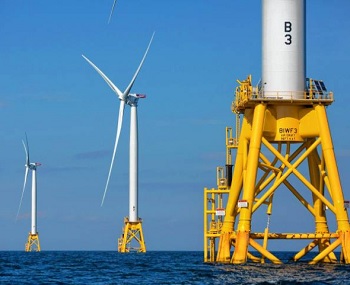
Offshore wind proponents, critics square off at Atlantic Shores hearing
Both proponents and critics of New Jersey offshore wind power generation faced off on Monday during a hearing for a project, that if approved, would construct up to 200 wind turbines less than 9 miles off the Jersey Shore. Atlantic Shores Offshore Wind, a project by the power companies Shell and EDF Renewables North America, promises to power about 700,000 homes in New Jersey through the construction of up to 200 ocean wind turbines. Supporters of the project say Atlantic Shores and other offshore wind projects are needed to quickly reduce greenhouse gas emissions, which are contributing to ocean warming, acidification, coastal flooding and stronger storms. But opponents of the project say it amounts to industrialization of the Atlantic Ocean and will irreparably harm a delicate coastal ecosystem. They argue Atlantic Shores will eliminate crucial scallop and oyster beds to commercial fishing and ruin the ocean view on which local tourism depends. Video, >click to read< 15:06
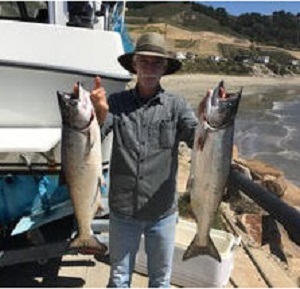
Will Morro Bay wind farms be the demise of Port San Luis?
I heard about the proposed Morro Bay Offshore Wind Farm awhile back but didn’t really think too much about it. But now I understand there is a plan to industrialize Port San Luis to be used as a base to assemble, operate, and maintain the 1,000 feet wind turbines for the wind farm and for the Vandenberg Space Force base to barge in rockets and components that are too large to travel by land. I am not sure this is such a good idea. I began to do some research on wind farms. This developed into hours and hours of digging through material. What I have learned is quite alarming. >click to read< 08:06
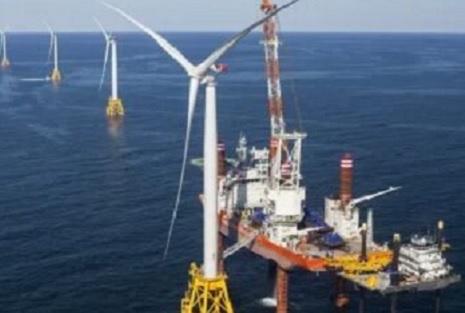
Oil Company con game exposed; the old switcheroo by Jim Lovgren
Oil companies developed techniques to not only locate oil and gas reserves thousands of feet below the ocean bottom, but to drill and recover them. Unfortunately, the tools used to locate oil reserves under the ocean floor, primarily seismic air gun arrays, have left a trail of dead sea creatures in its wake. Just like the US Navy, who for years denied the growing body of evidence linking military sonar usage to localized marine mammal strandings, the oil industry has denied any link of seismic research to the marine mammal strandings that invariably occur near their operations. Along comes Biden’s green new deal, and the east coast is now swamped with offshore research vessels using both sonar and seismic devises to map the sea floor and thousands of feet underneath it, for wind development. The same vessels in many cases that would have been involved with the 2012 proposed marine mammal massacre in search of oil reserves. These vessels are not only surveying the area in the lease site, but for many miles away from them, in many cases overlapping into other lease sites, or just mapping bottom that will never be available. Why? >click to read< 11:11
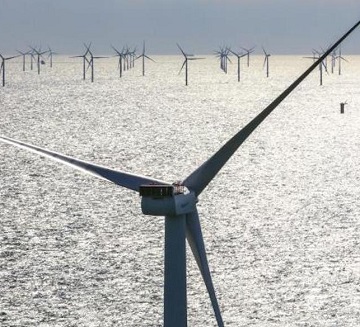
Offshore Windfarms Threaten to Pull Out of Uneconomical Contracts
A string of offshore wind projects meant to power Britain are in jeopardy after the global race to net zero sent costs soaring, casting doubt over the industry’s future as a cheap source of energy. A surge in supply chain costs has pushed up the price of wind turbines, while increases in global interest rates have raised refinancing costs substantially. It has made several projects unviable just a year after they won government subsidy contracts – leading to fears from industry insiders that Britain’s future is in jeopardy as the “Saudi Arabia of wind”. Schemes developed by Danish company Ørsted and Swedish player Vattenfall are among other projects understood to be at risk, as the industry seeks more government help to ensure projects remain viable. >click to read< 09:30
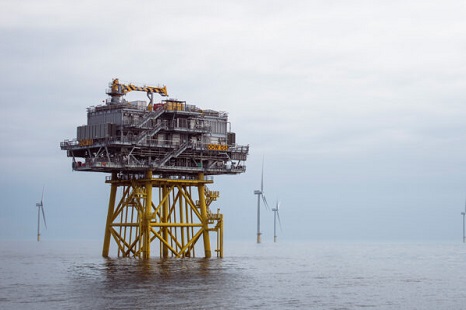
Offshore Wind Electrical Substations; The Secret, Silent Killers by Jim Lovgren
The marine mammal strandings that are taking place almost everyday along the US east coast are the most visible consequence of the Biden administration’s reckless disregard of all environmental safeguards that had been carefully crafted since the environmental movement started in the 1960’s. Embarrassingly, the cowards at the National Marine Fishery Service have stood by and watched as research vessels have been performing geologic surveys with high powered Sonar, and Seismic devises before they had their incidental take permits issued. They have also authorized over 100,000 level B takes of marine mammals, and that’s just for a few projects, as they fully expect the offshore wind factories to cause the extinction of the critically endangered Northern Right Whale. Just ask Sean Hayes, from the NMFS protected species department, whose observations were ignored by BOEM, hence an ESA violation. >click to read< 11:34

Government Watchdog Agrees to Probe Effects of Offshore Wind Turbines
Following a request from a group of Republican congressmen, the Government Accountability Office (GAO), an independent watchdog, has agreed to conduct an investigation into the environmental effects of offshore wind turbines, which the Biden administration has increasingly supported. The effort was spearheaded by Representative Chris Smith (R., N.J.), who sent a letter to the GAO’s comptroller requesting information about the effects in the North Atlantic Planning Area, which extends from Maine to New Jersey. Of particular interest is whether wind turbines will cause economic and marine-life problems affecting commercial fishing. >click to read< 07:38

Pipe Dream: The wind and solar power myth has finally been exposed
Many governments in the Western world have committed to “net zero” emissions of carbon in the near future. The US and UK both say they will deliver by 2050. It’s widely believed that wind and solar power can achieve this. This belief has led the US and British governments, among others, to promote and heavily subsidize wind and solar. These plans have a single, fatal flaw: they are reliant on the pipe dream that there is some affordable way to store surplus electricity at scale. Wind and solar need to be backed up, close to 100 per cent, by some other means of power generation. If that backup is provided by open-cycle gas or worse, coal, net zero will never be achieved: nor anything very close to it. >click to read< 09:02

Who will benefit from Morro Bay wind energy job creation?
California plans to rely on offshore wind energy to achieve its renewable energy goals. The off-shore wind farms are projected to generate 2,000 to 5,000 megawatts of energy by 2030 and 25,000 megawatts by 2045. Cyrus Ramezani and Mahdi Rastad’s 86-page report details the economic impacts of the Morro Bay wind energy projects and identifies the types of jobs that will be created. Last year, the federal government auctioned off three offshore wind energy sites located between 20 and 30 miles off the coast near Morro Bay. The report does not discuss the number of jobs the county will lose in the fishing and hospitality industries. >click to read< 16:30

Contrary to mainstream belief, wind turbines are neither effective nor, in many cases, good for the environment
Claims of wind power being pro-environment often do not consider the damaging effects these projects can have on wildlife and ecosystems, thus hiding the “true cost” of such initiatives. Wind power projects can threaten birds that fly within their vicinity and trigger a decline in their population; it can harm marine life due to noise pollution and affect the growth of plants in the region where it is located. Driven by subsidies granted by the federal government, the growth of wind projects has triggered concerns about the cumulative impacts they have on the environment. There have been growing protests against wind power projects across the world. In the United States, people have opposed setting up wind turbines in Lake Erie due to concerns about the environmental impact of the project. In New Jersey, protestors have asked to pause the development of an offshore wind farm which they claim has led to dolphins and whales washing ashore. >click to read< 12:38







